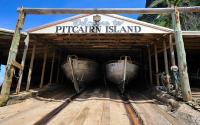 How would you like to escape to a tropical island, well off the beaten path, where land to build a house is free, temperatures stay above 62F all year round and there is even an internet connection? If that sounds good to you, you might want to consider Pitcairn Island.
How would you like to escape to a tropical island, well off the beaten path, where land to build a house is free, temperatures stay above 62F all year round and there is even an internet connection? If that sounds good to you, you might want to consider Pitcairn Island.
Yes, that Pitcairn Island, Britain’s smallest colony, the tiny island originally settled by mutineers from HMS Bounty. The population has been dwindling in recent years and now stands below 50.
As reported by the Telegraph: “We’ve been appealing for more people to boost the population,” said Jacqui Christian, 44, who represents the island in Europe. “We’ve had many enquiries but only one person has applied to move to Pitcairn.
“The reality is that we don’t really have any jobs to offer. Islanders used to sell stamps to raise funds but, of course, stamp collecting is not as popular as it once was.”
The population on the roughly 2 square mile island has fluctuated over time. Most of the island’s population is descended from the eight mutineers who settled on the island in 1789 after Christian mutinied against William Bligh, the Bounty’s captain. They brought six Polynesian men and twelve women from Tahiti with them. At first things did not go well. When an American whaler called on the island in 1808, murder and suicide had left eight of the nine mutineers dead.
By 1855, the population had grown to nearly 200, and the tiny island, with only 88 acres of flat land, could no longer sustain its people. As a result, Queen Victoria bequeathed them Norfolk Island, a former penal colony more than 3,700 miles to the west.
On May 3, 1856, the entire population of 194 people reluctantly abandoned Pitcairn. Within 18 months, however, seventeen of the immigrants returned to Pitcairn, followed by another four families in 1864. Contemporary Norfolk has approximately 1000 Bounty descendants–about half its population–and celebrates Bounty Day (the day the Pitcairners first arrived) on June 8. By just before World War II, the population had returned to close to 200 again.
Pitcairn’s reputation was tarnished by a child abuse scandal in 2004, when six men were imprisoned for sexual offences, including Steve Christian, the mayor and a descendant of Fletcher.
There is only one general store on the island, which opens three times a week. Orders for food from New Zealand must be placed every three months.
Ms Christian admitted that the island’s location seemed like “the middle of nowhere”.
“But once you are there, you are as connected as anywhere else,” she said. “The island has electricity and the internet now.
“It is a special place and it is beautiful seeing the stars without light pollution. There are the bluest waters you have ever seen.”

How do I find out more
I’d like to go for about 3 months a year. Fishing all day and getting my daily read of the Old Salt Blog in the evenings:)
You might try: https://pitcairn-island.visahq.com/embassy/united-states/
You’d have to be nuts or have a death wish to move there.
http://www.ancient-origins.net/history/real-life-lord-flies-strange-and-violent-history-pitcairn-island-003557
Two UK Navy’s Naval Service ships have just visited the most remote island in the world where they helped islanders carry out two years work in just a few days.
As part of her nine month deployment the Portsmouth based frigate HMS Lancaster visited Tristan Da Cunha and was joined there by Royal Fleet Auxiliary Ship Gold Rover.
The visit was exceptionally busy for both vessels, especially for Lancaster’s Wildcat helicopter and crew, who flew essential stores around the island to remote areas.
In total both ships helped islanders lift and shift equipment and supplies that would have take two years of manual work.
Tristan Da Cunha is located approximately 1,750 miles away from South Africa, and 1,500 miles away from the nearest land mass – the island of St Helena – which makes it the most remote inhabited island in the world.
HMS Lancaster is half way through a nine month deployment. So far the ship and her crew have travelled 22,000 miles with 10 port visits over three continents.